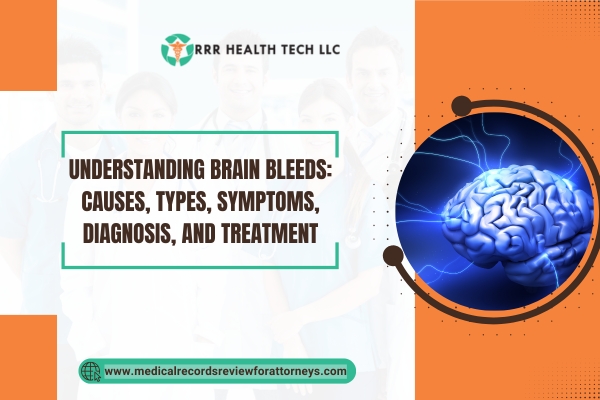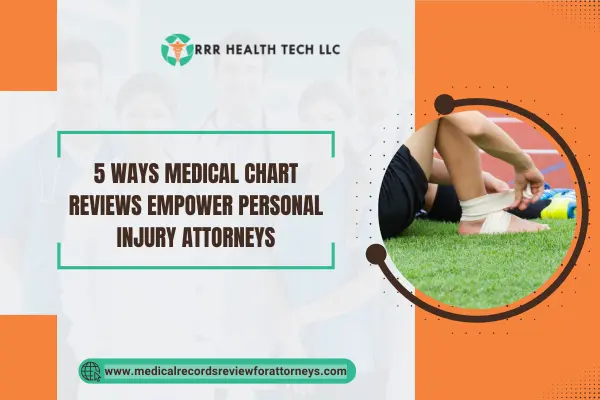
Introduction
Bleeding inside skulls is a medical emergency referred to as brain bleeds or intracranial haematomas which may lead to other dangerous outcomes like loss of normal functioning or even death. It is imperative that professionals working in delicate areas such as medical practice, personal injury law firms or reorganizing peoples’ lives affected by these circumstances understand the intricacies of this condition. We seek to focus on these details and offer an all-around look into what a brain bleed is – its causative factors, types, how it manifests, diagnosis, and available treatment. Moreover, we will examine the importance of a medical record review service in the legal industry in the United States of America.
What Can Cause Bleeding in the Brain?
Bleeding in the brain can occur due to various factors, including:
Trauma
• Head Injuries: Trauma caused by falls, vehicles, or even sports can lead to brain bleeds.
Medical Conditions
• Aneurysms: These are weakened areas in the walls of blood vessels that can burst.
• Arteriovenous Malformations (AVMs): Presence of congenital ventral vessels can facilitate large pulse pressure resulting to haemorrhage.
• Hypertension: Arterial pressure that is high running over the normal levels for a long time will lead to blood vessel walls breaking.
Blood Disorders
- Coagulopathy: These are disorders such as haemophilia or use of anticoagulant medicine that affect blood clotting thereby bleeding being elevated in situations where stimulation is done.
Tumors
- Cerebral Tumors: Tumors can invade blood vessels or cause them to rupture.
Types of Brain Bleeds
Understanding the different types of brain bleeds is crucial for diagnosis and treatment:
Subdural Hematoma
• Definition: Encapsulated collection of blood between the brain and the inner layer of the dura mater. This most often is associated with an injury to the overlying head.
Epidural Hematoma
• Definition: It’s located in the space between the dura mater and the skull bone, often resulting in a splinter fracture.
Intracerebral Hemorrhage
• Definition: Spontaneous bleeding into the brain parenchyma itself, which is common after trauma or in those with high blood pressure.
Subarachnoid Hemorrhage
• Definition: This bleeding occurs in the space between the surface of the brain and the structures that envelopes the brain. Frequent cause of this type of bleeding is the presence of an aneurysm.
Symptoms of Brain Bleeds
Recognizing the symptoms of brain bleeds is vital for timely medical intervention. Symptoms may vary based on the type and location of the bleed but commonly include:
- Severe Head Ache: More instances of a sudden intense headache have been revisited.
- Confusion: Some fragmentation of thoughts where a person is un-comprehending can occur.
- Weakness or Numbness: Users of one side of the body may become weak or in some instances entirely numb.
- Seizures: The presence of seizures in some patients due to the bleed can be noted.
- Vision defects: Those affected by the condition may include blurred vision and even double vision.
- Nausea and Vomiting: These symptoms may show up during headaches.
Causes of Brain Bleeds
Trauma
As was stated before, trauma is one of the leading causes of brain bleeds. Establishing the context of the injury is important for most legal cases especially for lawyers representing injured people in circumstances of accidents.
Medical conditions
There are certain chronic systems that include hypertension and blood conditions that have been shown to lead to bleeding in the brains. This information might be useful to lawyers who are analysing the medical records of a case based on negligence malpractice.
Lifestyle Factors
• Smoking and Alcohol Use: These habits come hand in hand with vascular problems that increase the possibilities of bleeding.
• Obesity: This condition can lead to hypertension among other disorders.
Diagnosis of Brain Bleeds
Diagnosing a brain bleed typically involves a combination of clinical evaluation and imaging studies:
Neurological Examination
• Usually, the physicians will perform this procedure in order to test the patient’s cognition, reflexes and the patient’s ability to manage body movements.
Imaging Studies
• CT Scans: This is the greatest possible test for bleeding inside the brain.
• MRI: These help visualize brain structures and give an idea of the severity of the bleeding that happened.
Laboratory Tests
• It is possible to carry out blood tests aimed at identifying clotting defects or other diseases that may be present.
Treatment of Brain Bleeds
Treatment options for brain bleeds depend on the type and severity of the bleed:
Observation.
• For some of the minor bleeds no immediate surgery is necessary.
medications
• Antihypertensive drugs: For treatment of high BP.
• Anticoagulants: Blood thinners may be dosed down or omitted if the patient has been on the
Surgical Interventions
- Craniotomy: In severe cases, a craniotomy may be performed to remove the blood and relieve pressure on the brain.
- Endovascular Procedures: Minimally invasive techniques can be used to treat aneurysms or AVMs.
How Medical Record Review Services Assist Attorneys
Medical record review services play a pivotal role in helping attorneys navigate complex cases involving brain bleeds. These services provide:
1. Comprehensive Analysis
Experts analyze medical records to identify critical information regarding the patient’s condition, treatment history, and potential negligence.
2. Expert Testimony
Medical record reviewers can provide expert testimony regarding the standard of care and whether it was met in the case at hand.
3. Case Preparation
By summarizing medical records and highlighting key points, these services help attorneys build stronger cases for their clients.
Conclusion
It is important for both doctors and attorneys practicing in the field to gain an understanding of brain bleeds. Such knowledge enables attorneys to better represent their client who is suffering from the complications of such grievous conditions, as it includes different causes, types, symptoms, diagnosis, and treatment options. Review of medical records is useful to this process as it equips the injured with relevant information and expert review in the quest to seek resources for the victims of the brain bleeds.


